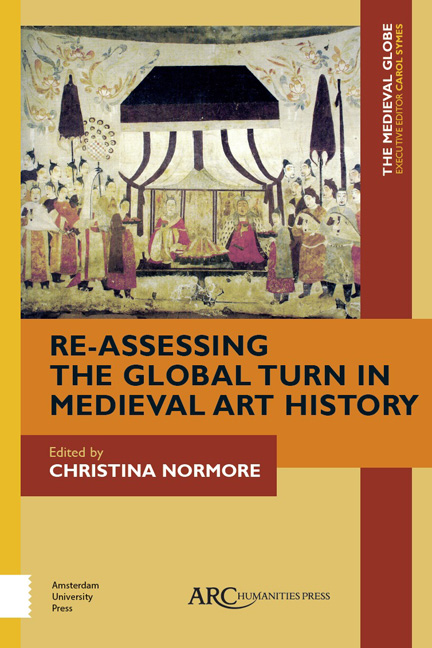Book contents
- Frontmatter
- Contents
- List of Illustrations
- Editor’s Introduction: A World within Worlds? Reassessing the Global Turn in Medieval Art History
- A Camel’s Pace: A Cautionary Global
- The Fatimid Holy City: Rebuilding Jerusalem in the Eleventh Century
- Worldliness in Byzantium and Beyond: Reassessing the Visual Networks of Barlaam and Ioasaph
- Exchange of Sacrifices: West Africa in the Medieval World of Goods
- The Beryozovo Cup: A Byzantine Object at the Crossroads of TwelfthCentury Eurasia
- Mobile Meanings: A Global Approach to a Dagger from Greater Syria
- Global Medieval at the “End of the Silk Road,” circa 756 CE: The Shōsō-in Collection in Japan
- Response: Medievalists and Early Modernists—A World Divided?
- Index
A Camel’s Pace: A Cautionary Global
Published online by Cambridge University Press: 23 January 2021
- Frontmatter
- Contents
- List of Illustrations
- Editor’s Introduction: A World within Worlds? Reassessing the Global Turn in Medieval Art History
- A Camel’s Pace: A Cautionary Global
- The Fatimid Holy City: Rebuilding Jerusalem in the Eleventh Century
- Worldliness in Byzantium and Beyond: Reassessing the Visual Networks of Barlaam and Ioasaph
- Exchange of Sacrifices: West Africa in the Medieval World of Goods
- The Beryozovo Cup: A Byzantine Object at the Crossroads of TwelfthCentury Eurasia
- Mobile Meanings: A Global Approach to a Dagger from Greater Syria
- Global Medieval at the “End of the Silk Road,” circa 756 CE: The Shōsō-in Collection in Japan
- Response: Medievalists and Early Modernists—A World Divided?
- Index
Summary
THIS ESSAY SEEKS to disentangle various interpretations of “the global” and to consider this trend's risks and rewards for the study of art in “medieval” China. Specifically, I want to sound a note of caution concerning the use of global as an analytical frame for premodern eras, particularly as the term has been variously defined in current art historical writing dominated by scholars of modern and contemporary EuroAmerican art.At the same time, I want to distinguish productive epistemic shifts that stem from the global turn within art history for the study of Chinese art. While some dominant models of the global have resulted in problematic essentialism and misreadings, others offer a useful lens through which to reconsider both China's nationalist historiography and the complex material record of past civilizations.
My concerns echo those of a recent discussion of the rise of “world art history” among scholars of ancient art, moderated by Jeremy Tanner.Tanner asked these scholars whether they saw the rise of global art as representing epistemic or organizational changes in the disciplines of art history and archaeology. Two issues, lamented and praised, emerged in their responses: the death of history, or the potential loss of any “deep historical grasp of how objects may develop within specific cultural constraints,” and comparative art history, a practice that would engender dialogue across regions.While accepting that comparative art history is essential, Jas Elsner remarked that “before we can even attempt some kind of comparative model of approach, we have to recognize the totally uneven basis of our scholarly starting points in relation to the cultures and arts we want to compare.” Elsner refers not only to the Eurocentric roots of art history, but also cautions about formidable impediments for making productive comparisons across regions. In particular, he notes the relative lack of emic intellectual perspectives on nonEuropean arts and the differences between regions with and those without a comprehensive corpus of edited and translated texts that may facilitate art historical interpretation. Meaningful comparisons between regions requires roughly balanced sets of sources; and despite the vast material, textual, and oral traditions in Africa, China, India, or the Islamic world, these regions have not yet attracted generations of scholars to the study of their art forms in a way parallel to classic traditions in Europe.
- Type
- Chapter
- Information
- Re-Assessing the Global Turn in Medieval Art History , pp. 11 - 34Publisher: Amsterdam University PressPrint publication year: 2018



